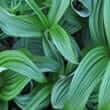Background
- American hellebore is a perennial plant native to the swampy areas and moist meadows of the eastern and western United States. The root and rhizome of American hellebore has been used historically for fever, pain, and high blood pressure, with a decoction (boiled in water) of the root being used for chronic coughs and constipation. Historically, the whole plant was not routinely used medicinally, only the root and rhizome. Although American hellebore was formerly used as a tea or tincture, potentially toxic and irritating constituents preclude its modern day use by ingestion.
- The toxic effects associated with American hellebore limit its ability to be used as an agent to treat hypertension (high blood pressure), related kidney/heart diseases, and hypertension associated with pre-eclampsia in pregnancy.
- Currently, there is a lack of scientific information regarding the safety or effectiveness of American hellebore as a whole plant, or homeopathically. Most studies have investigated the isolated jervine alkaloids.
References
Natural Standard developed the above evidence-based information based on a thorough systematic review of the available scientific articles. For comprehensive information about alternative and complementary therapies on the professional level, go to . Selected references are listed below.
- Barrow JG, Sikes CR. The use of purified veratrum viride alkaloids in the treatment of essential hypertension. Am Heart J 1951;41(5):742-748.
View Abstract - Royce SW. Hypertension in childhood; treatment of acute nephritis with a derivative of veratrum viride. Calif.Med 1956;84(5):347-350.
View Abstract - Brunner D, Aaltman S, Schindel L. Hypertension treatment with alkaloids of Veratrum viride and Veratrum album alone or in combination with hexamethonium salts. Acta Med Scand 1955;151(6):487-498.
View Abstract - Faust FB. Veratrum viride in the treatment of essential hypertension; a report of 40 cases. J Lancet 1951;71(2):65-68.
View Abstract - Gaillard, Y. and Pepin, G. LC-EI-MS determination of veratridine and cevadine in two fatal cases of Veratrum album poisoning. J Anal.Toxicol. 2001;25(6):481-485.
View Abstract - Gebhardt R. Antioxidative, antiproliferative and biochemical effects in HepG2 cells of a homeopathic remedy and its constituent plant tinctures tested separately or in combination. Arzneimittelforschung 2003;53(12):823-830.
View Abstract - Joiner C, Kauntze R. Arterial hypertension treated with Rauwolfia serpentina and veratrum viride. Lancet 5-29-1954;266(6822):1097-1099.
View Abstract - Kauntze R, Trounce J. Treatment of arterial hypertension with veriloid (Veratrum viride). Lancet 12-1-1951;2(22):1002-1008.
View Abstract - Meilman E, Krayer, O. Clinical studies on veratrum alkaloids; the action of protoveratrine and veratridine in hypertension. Circulation 1950;1(2):204-213.
View Abstract - Mills LC, Moyer JH. Treatment of hypertension with orally and parenterally administered purified extracts of veratrum viride; comparison with ganglionic (Hexamethonium) and adrenergic blocking agents. AMA.Arch Intern Med 1952;90(5):587-601.
View Abstract - Prince, L. A. and Stork, C. M. Prolonged cardiotoxicity from poison lilly (Veratrum viride). Vet.Hum.Toxicol. 2000;42(5):282-285.
View Abstract - Shapiro AP, Brust AA, Ferris EB. A comparative study of the effects of Veratrum viride and tetraethylammonium chloride in hypertension. Ann Intern Med 1952;36(3):807-810.
View Abstract - Tosun F, et al. The Evaluation of Plants from Turkey for in Vitro Antimycobacterial Activity. 2005;43(1):58-63. Pharmaceutical Biology 2005;43(1):58-63.
- Van Wassenhoven M. Towards an evidence-based repertory: clinical evaluation of Veratrum album. Homeopathy 2004;93(2):71-77.
- Zagler B, Zelger A, Salvatore C, et al. Dietary poisoning with Veratrum album--a report of two cases. Wien.Klin.Wochenschr. 2005;117(3):106-108.
View Abstract







